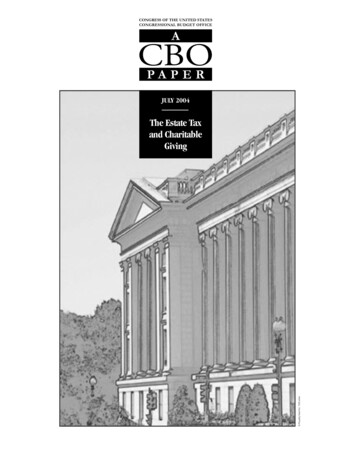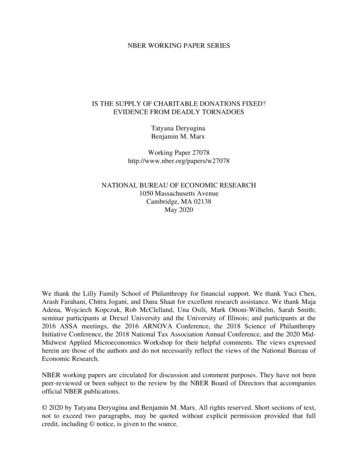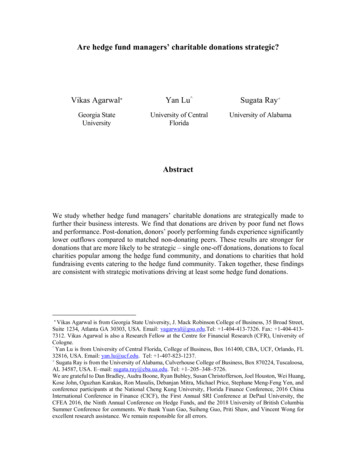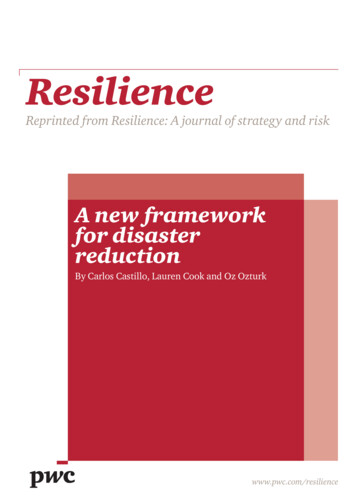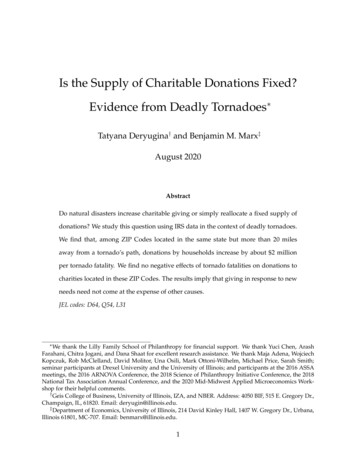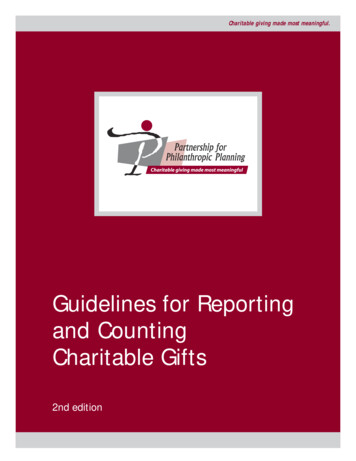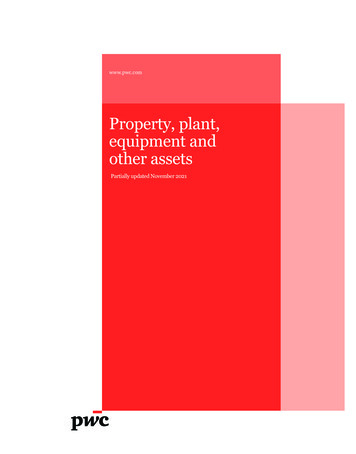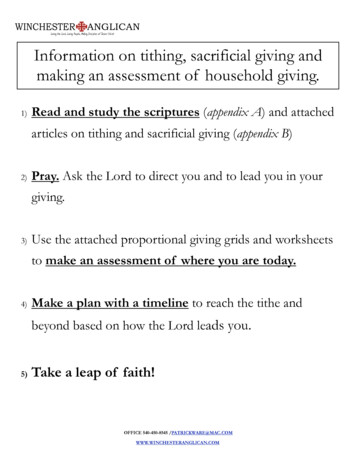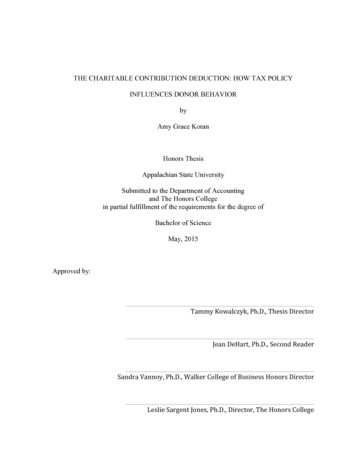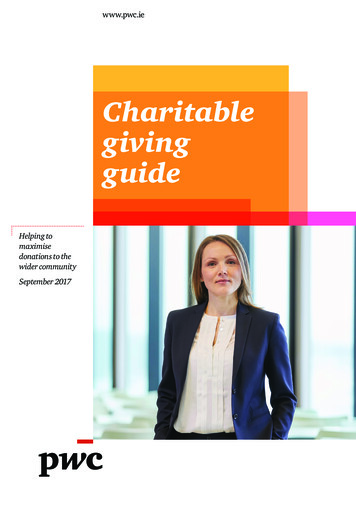
Transcription
www.pwc.ieCharitablegivingguideHelping tomaximisedonations to thewider communitySeptember 2017
Contents1Introduction32Tax relief for donations to eligible charities and other approved bodies52.1 Donations made by individuals on or after 1 January 201362.2 Corporate donations83 Gifts and bequests to charities –gift tax, inheritance tax and capital gains tax exemptions114Taxes payable by charities – VAT and stamp duty175Donations supporting Innovations216Philanthropy277Frequently asked questions298Appendices338.1 Appendix 1 - List of other approved bodies338.2 Appendix 2 - Tax relief position prior to 1 January 2013348.3 Appendix 3 - Comparison of tax relief pre and post 2013428.4 Appendix 4 - Donations to approved sports bodies44www.pwc.ie 1
Introduction1
Charitable giving offers many benefits to donors and to thewider community. This guide will help you determine themost cost-effective way to structure your donations. TheIrish tax system contains a range of incentives aimed atfacilitating and encouraging charitable giving by individualsand companies, which help to ensure that charities receivethe maximum benefit from public and private donations.Many individuals and companies are unaware of theseincentives, which can enhance the benefit of the donationsfor charities or provide tax relief for the corporate donor.This can result in the incentives being underused, effectivelydenying charities valuable resources to fund their work.The aim of this guide is to provide an overview of therange of tax incentives available in Ireland and in doingso to maximise the level of funding available throughcharitable giving.This guide represents the legislative position at time ofpublication (September 2017).www.pwc.ie 3
Tax relief for donations toeligible charities and otherapproved bodies2
Tax relief is available for donations by bothindividuals and companies provided: there is a donation of money or of shares,stock or debentures of a class quoted on arecognised stock exchange, the recipient is either an “eligible charity”or another approved body, there is no arrangement that the donationcan be repaid, neither the donor nor anyone connectedwith the donor benefits from the donation, the donation does not depend on and isnot conditional upon the acquisition ofproperty by the charity otherwise thanby way of a gift from the donor, an individual donor is resident inIreland (corporate donations may bemade by branches of foreign companiesin Ireland), and the minimum donation in any year toany one eligible charity or approvedbody is 250.An eligible charity is any charity in Irelandwhich is authorised in writing by theRevenue Commissioners for the purposes ofthe scheme of tax relief. Amendments tolegislation in Finance Act 2010 mean thatcharities established in the EuropeanEconomic Area, and members of theEuropean Free Trade Association, may alsoapply to be eligible charities in Ireland. A listof authorised charities can be found in thePublications section of the RevenueCommissioners’ website, or at ies.html.Although a charity can apply for income/corporation tax exemption on its ownincome as soon as it is established, it isnot permitted to join the list of “eligiblecharities” (for the tax relief scheme) until ithas been tax exempt on its own income for atleast two years.See appendix 1 for the list of other “approvedbodies”.www.pwc.ie 5
2.1 The following is asummary of the positionin relation to donationsby individuals on or after 1January 2013. The previousposition is set out inAppendix 2. Donations from all individual donors aretreated in the same manner, with the taxrelief in all cases being repaid to thecharity. Self-assessed taxpayers can nolonger claim a deduction on their taxreturns for donations. A blended rate of relief (31%) applies forall taxpayers regardless of their marginaltax rate, subject to the taxpayer havingpaid at least the amount of tax beingclaimed by the charity. All donationsshould be grossed up as previously donefor donations from PAYE taxpayers. The charitable donations scheme is notwithin the scope of the high earners’restriction. The total amount of donations forwhich relief can be claimed is limitedto 1 million per individual, per annum. A restriction of the donation to 10% of theindividual’s total income, where the donoris associated with the charity, also applies.www.pwc.com/ie 6 The administration of the scheme has alsobeen simplified in that bodies will bepermitted to use “Enduring Certificates”from donors that can last up to amaximum of 5 years (CHY3 Cert). Thereis also an option to complete an “AnnualCertificate” in respect of donations madein a single year (CHY4 Cert).These forms can be found on the RevenueCommissionaires website rities.html. The charity is only required to record thedonor’s PPSN the first time a declaration issigned. Thereafter, charities will use theirown identifier for any communicationswith the donor. Bodies must register for the scheme bycompleting a CDS Tax Registration Form. Bodies must submit refund claims to theRevenue Commissioners electronically. Claims will not be processed until after theappropriate returns have been received byRevenue. In the case of a PAYE donor theappropriate return is the employer’s FormP35 for the year in which the donation ismade, and in the case of a self-assesseddonor it is the donor’s tax return for theyear in which the donation is made.
Example 1Cash donation by anindividual – PAYEtaxpayer or selfassessed tax payer In 2014, Alan Allman donates 400 to an eligible charity. Alan has paid sufficient tax to cover the tax refund due to thecharity and the relevant appropriate returns in support of the taxpaid have been made. The value of the donation to the charity is 579 ( 400 x 100/69).This comprises the 400 payment by Alan plus the tax associatedwith the donation of 179 ( 579 - 400). The charity may claim a repayment of 179 from the RevenueCommissioners once it is in receipt of either an enduring or annualcertificate from Alan. The donation costs Alan 400.Example 2Donation of quotedshares by anindividualIn 2014, Breda Brien donates quoted shares with a market value, atthe date of donation, of 600 to an eligible charity. She does not wishto claim CGT relief on the donation (see Section 3) Breda has paid sufficient tax to cover the tax refund due to thecharity and the relevant appropriate returns in support of the taxpaid have been made. The value of the donation to the charity is 869 ( 600 x 100/69).This comprises the shares valued at 600 and the tax associatedwith the donation, which is 269( 869 - 600). The charity may claim a repayment of 269 from the RevenueCommissioners once it is in receipt of either an enduring or annualcertificate from Breda. Breda reports the transfer of shares to the charity on her taxreturn, and may (subject to her personal exemption on gains of 1,270 per year) be liable for capital gains tax at 33% on thedifference between the value of the shares transferred and theoriginal cost of the shares. The donation costs Breda 600 plus any capital gains tax payableon the shares. The charity will not be liable to capital gains tax on any subsequentsale of the shares provided the proceeds on the sale are applied forits charitable purposeswww.pwc.ie 7
2.2 Corporate DonationsCompanies claim tax relief by deducting thedonation (which would otherwise be nondeductible) as if it were a trading expense ora management expense for the financialaccounting period in which it is made.Example 3Cash donationby a companyWhere the donation is made in a shortaccounting period (less than twelve months)the minimum donation of 250 is reducedproportionately. A receipt for the donationshould be obtained from the charity orapproved body.In 2014, International Distribution Limited donates 2,000 to aneligible charity. International Distribution Limited gets tax relief on the 2,000donation at 12.5% ( 250). International Distribution Limited claims a deduction for thedonation as a trading expense. No repayment claim can be madeby the charity. The donation costs International Distribution Limited 1,750. The value of the donation to the charity is 2,000,ie the cash received.www.pwc.com/ie 8
Example 4Donation of quotedshares by a companyJoiners Ireland Limited donates quoted shares with a market valueof 2,200 to an eligible charity. Joiners Ireland Limited gets tax relief on the 2,200 donation at12.5% ( 275). Joiners Ireland Limited claims a deduction as a trading expense.No repayment claim can be made by the charity. Joiners Ireland Limited is liable for capital gains tax at 33% onthe difference between the value of the shares transferred andthe original cost of the shares. If the CGT liability is higher than thetax relief on the donation Joiners Ireland could consider claimingthe CGT relief available on disposals to charities instead (seeSection 3). If the corporation tax deduction is claimed, the donation costsJoiners Ireland Limited 1,925 plus any capital gains tax liabilityon the shares. The value of the donation to the charity is 2,200, ie the marketvalue of the shares received. The charity will not be liable to capital gains tax on any subsequentsale of the shares provided the proceeds on the sale are applied forits charitable purposes.www.pwc.ie 9
Gifts and bequests tocharities – gift tax,inheritance tax andcapital gains tax3
As a general matter, a gift tax or inheritancetax liability may arise on a person whoreceives a gift or an inheritance, and donorsmust separately consider whether capitalgains tax is due by them on the transfer ofassets by way of a gift.The exemption from gift tax and inheritancetax is broader than other exemptions inrespect of charitable giving to the extent thata public purpose might be one which is nototherwise regarded as charitable.A benefit taken for public or charitablepurposes is exempt from gift tax andinheritance tax to the extent that theRevenue Commissioners are satisfied thatthe benefit has been, or will be, applied forpurposes which in accordance with Irish laware public or charitable. Thus, charities inreceipt of gifts or bequests are not generallysubject to any taxation themselves on receiptof the funds.www.pwc.ie 11
Example 5Bequest to a charityKathleen Kelly provides in her will to leave 100,000 to an animalwelfare charity. The receipt of the legacy by the charity on Kathleen’s death isexempt from inheritance tax.Example 6Individual recipientof charitable fundsLarry Lawrence receives financial funding from a charity in order topurchase special equipment to cater for his specific medical needs. The receipt of funds by Larry is exempt from gift tax.Gifts and bequests may be made to charitieseither in cash form or in the form of atransfer of property to the charity. Nocapital gains tax arises on a bequest, or on atransfer of cash, but an individual or acompany making a gift of property (asopposed to cash) needs to bear any capitalgains tax implications in mind. Capitalgains tax arises where an asset (e.g. aninvestment property) has increased in valuesince it was acquired by the donor and theasset is either sold or given away. It does notgenerally feature where there has been noincrease in value.www.pwc.com/ie 12There is a special relief from capital gainstax where a donor transfers an asset to acharity for less than its market value. Thenormal rule requiring the disposal to betreated for tax purposes as made at marketvalue does not apply and the disposal isdeemed to be for a consideration whichwould ensure that neither a gain nor a lossaccrues on the disposal, so the individual orcompany making the gift is not subject tocapital gains tax.This special treatment does not apply togifts of quoted shares for which income taxor corporation tax relief has been claimed.As outlined in section 2 of the guide, thedonor may be liable to pay capital gains taxon these gifts, and a donation cannotqualify for both income tax/corporation taxand capital gains tax relief. The choice as towhich relief applies ultimately rests with thedonor, and where the donation of shares ismade by an individual, the individual mustadvise the charity if he/she is claiming theCGT relief.
Example 7Comparision of CGTrelief for donor vstax relief for charityIn 2014, Mike McMahon donates shares worth 10,000 to an eligiblecharity. He has a taxable capital gain of 5,000 on the shares. He haspaid sufficient tax to enable the charity make a full tax reclaim inrespect of the donation. The table below illustrates the effect of theCGT relief vs the income tax refund available to the charity.Tax relieffor charityORCGT reliefclaimed by JoeCGT due by Joe 1,6500Income taxrefund to charity 4,4920Net Cost to Joe 11,650 10,000Net benefit to charity 14,492 10,000www.pwc.ie 13
Example 8Gift of investmentproperty by anindividualJohn Jordan bought a house in May 1992 for 150,000. In January2014 he made a gift of the house to a charity supporting the homelessso that they could convert it into a shelter. At that time the house wasvalued at 400,000 and had not been his principal private residence. The making of the gift is treated as a disposal for capital gainstax purposes and John is treated as disposing of the house tothe charity. John is deemed to have disposed of the property to the charity for 150,000 (plus any costs of acquisition or disposal of the property),giving no gain/no loss for tax purposes.www.pwc.com/ie 14
Subsequent sale of donated propertyby charityIf the donated property is subsequently soldby the charity and the disposal is madewithin the ambit of the general relief forcharities i.e. the gain arising has been or willbe applied for charitable purposes, then noissues arise, and the disposal is exempt fromcapital gains tax in the hands of the charity.However, if the gain arising is not applied forcharitable purposes, the gain is not exemptfrom capital gains tax, and a capital gainstax liability also arises to the charity on theoriginal disposal by John as if the propertyhad been disposed of by the donor at marketvalue at that time. Both gains are assessedon the trustees of the charity.Example 9Same facts as example 8, but the charity subsequently sells thehouse in December 2014 for 440,000 and applies the proceedsfor charitable purposes.In these circumstances the trustees of the charity are exempt fromtax on the gain during their ownership of the property and there isno change in the exemption on the original disposal by John tothe charity.Example 10Same facts as example 8, but the charity subsequently sells thehouse in December 2014 for 440,000 and the proceeds are notapplied for charitable purposes.The trustees of the charity are liable to capital gains tax in respect oftwo disposals: disposal by John to the charity in January 2014 in respect of whichJohn is deemed to have disposed of the house at market value i.e. 400,000, with a base cost of 150,000, and disposal by the charity in December 2014. As the proceeds of thedisposal were not applied for charitable purposes, the trustees areliable to capital gains tax on any gain arising. The base cost is themarket value of the house at the date on which the donation wasmade, 400,000, and the proceeds are 440,000.www.pwc.ie 15
Taxes payable by charities –VAT and stamp duty4www.pwc.com/ie 16
VATFrom a VAT perspective, charities are notgenerally regarding as supplying goods orservices in the course or furtherance of abusiness and as such are neither obliged norentitled to register and account for VAT.However, this is not the case in allcircumstances and consequently VATregistration may be required if the charity isseen to be trading i.e. engaged incommercial activity, or it acquires or is likelyto acquire more than 41k (in any period of12 months) worth of goods from other EUmember states. Where a charity is registeredfor VAT, they may be obliged to account forVAT on services from abroad. As a result,whether a charity needs to be VAT registeredneeds to be determined on a charity bycharity basis.Voluntary donations, whether made bymembers of the general public, corporateentities or by Government institutions,should generally be outside the scope of VAT.This will be the case if it is clear that there isno obligation (contractual or otherwise) forthe charity to provide anything in return i.e.the donation is not considered to beconsideration received for the supply ofgoods or services. If there is such anobligation, the charity may be makingsupplies in the course or furtherance ofbusiness and may in turn have an obligationto charge VAT on such supplies(if it does not qualify for VAT exemption).As most charities are generally outside thescope of VAT and so not in a position toreclaim it, the VAT incurred on purchasestends to be a real cost. However, for certainexpenditure funded by voluntary donations,there are some reliefs in place which allowcharities to reclaim the VAT incurred.www.pwc.ie 17
Donated Medical EquipmentDonated Research EquipmentVAT may be repaid to a hospital or donor onthe purchase of a new medical instrument/appliance (excluding means of transport)which is funded by voluntary donations.However it must;VAT incurred in the purchase or importationof new instruments, funded by voluntarydonations to a research institution,university, school or similar educationalbody engaged in medical laboratory basedresearch, may be refunded provided theconditions set out in the precedingparagraph are met. Cost 25,390 or more (ex-VAT) Be designed and manufactured for usesolely in medical research or in diagnosisprevention or treatment of illness Not have been part-funded by the Stateand The Minister for Health must recommendthat, having regard to the requirements ofthe health service, a VAT refund would beappropriate.www.pwc.com/ie 18In addition, there are other reliefs in placein respect of VAT incurred on the purchase/adaptation of vehicles for the transport ofseverely and permanently disabled persons,appliances for use by disabled persons,radios for the blind, certain sea rescue craftand equipment and goods purchased forexportation by philanthropic organisationsfor humanitarian, charitable or teachingactivities outside of Ireland.
Stamp dutyThere is no general exemption from stampduty for charities. In general, it is thetransferee or purchaser who is accountablefor the payment of stamp duty and as such acharity will only be liable to stamp duty inthe event that a stampable instrument isexecuted on the transfer of an asset tothe charity.There is a specific stamp duty exemption forconveyances or transfers (whether on sale orby way of gift) or leases to a charity of landwhich will be used for charitable purposes inIreland or Northern Ireland.Thus, a charity acquiring a property for useas part of its charitable activities may qualifyfor stamp duty exemption, but a charitypurchasing shares is normally subject tostamp duty. An exemption is also availablewhere a donor donates quoted securities tothe charity and the donation qualifies forincome tax relief.www.pwc.ie 19
Donations supporting Innovation5
Supporting scientific researchAny trading company or self-employedindividual can claim a tax deduction, incomputing the profits of the trade, in respectof any capital or revenue expenditure onscientific research, whether or not thescientific research relates to the companyor individual’s business. This gives anopportunity to provide support, in a taxeffective way, to research activitiesundertaken by, for example, medical orother charities.“Scientific research” is defined for thispurpose as “any activities in the fields ofnatural or applied science for the extensionof knowledge”.The benefit of the tax deduction in respect ofan individual donor depends on themarginal rate of income tax for theindividual. The rate of corporation tax(generally 12.5%) determines the benefit ofthe tax deduction in the case of a company.Assistance through sponsorship oradvertising expenditureA tax deduction may be claimed by acompany or self-employed individual inrespect of sponsorship/advertising paidto a charity, provided the payment is madewholly and exclusively for the purposesof a trade. There is no de minimis amountrequired to qualify for this tax relief.Sponsorship or advertising is different froma donation of money as the company orindividual gets something in return andtherefore tax relief is not available underthe scheme of tax relief for donations toeligible charities and other approved bodies.In order to claim a deduction for suchexpenditure as a legitimate trading expense,it must be shown that the individual orcompany has, for example, received publicityin respect of the business or one of itsproducts, that represents a reasonablereturn for the amount paid to the charity.www.pwc.ie 21
Other tax effective donationsDonation of heritage itemsTax relief is available in respect of thedonation to the Irish national collections ofimportant national heritage items. The reliefconsists of a tax credit equal to 80% of thevalue of the heritage item or items donated,which can be credited against particular taxliabilities incurred by the donor, includingincome tax, corporation tax, capital gainstax, gift tax and inheritance tax.For the purpose of the relief, heritage itemsmean any kind of cultural item including: any archaeological item, book, estaterecord, manuscript and painting, and any collection of cultural items and anycollection in its setting consideredappropriate for donation to the nationalcollectionswww.pwc.com/ie 22The “national collections” to which thedonations of the heritage items must bemade for the purpose of the relief include: the National Archives the National Gallery of Ireland the National Library of Ireland the National Museum of Ireland the Crawford Art Gallery Cork Limited the National Museum of Modern Art, or any other body (being a body owned, orfunded wholly or mainly, by the State orany public or local authority) as may beapproved by the Department of Culture,Heritage and the Gaeltacht.
For the relief to apply a number of conditionsmust be satisfied. These include a successfulapplication to the Department of Culture,Heritage and the Gaeltacht that the itembeing donated is a “heritage item”, avaluation of the heritage item by theRevenue Commissioners and the issuing of acertificate to the taxpayer certifying thechange of ownership to the nationalcollection. This certificate is also given to theRevenue Commissioners to confirm theavailability of the tax credit on request fromthe donor.In order to obtain the tax credit, the heritageitem or items must be donated for noconsideration and the open market value ofthe item (or collection of items) must be atleast 150,000 (in the case of a collection, atleast one item in the collection mustgenerally have a minimum value of 50,000).The donor is not entitled to any other taxbenefit in respect of the donation so capitalgains tax may be payable on the donation ofa heritage item by a donor. The capital gainstax relief for donated property (described insection 3) would not be available and marketvalue proceeds would be imputed.This relief is a specified relief for thepurposes of the high earner’s restriction.www.pwc.ie 23
Example 11Jilverton Sales Limited contributes 3,500 to an Irish registeredinternational humanitarian charity on the understanding that thecharity will provide advertising opportunities. These would include, for example, advertisements displayed at thecharity’s premises, at its fundraising functions or on brochurespublished by it. The payment of 3,500 should represent a reasonable payment forthe benefit received to enable the full amount to be deducted as alegitimate trading expense.www.pwc.com/ie 24
www.pwc.ie 25
Philanthropy6
Philanthropy is effectively a process ofplanned giving whereby individuals,families and corporate bodies can contributeto charities thorough a structured and taxefficient approach.Philanthropic giving can be achieved in anumber of different ways but among themost popular methods are:i. Establishing a charitable fund/foundationA fund/foundation is a personal fund raisingvehicle that distributes donations from anindividual, family or corporate body to aportfolio of beneficiaries. It can be focusedon particular causes or it can be broad in itsapproach to giving. A fund/foundation is thebest option for those seeking maximumflexibility and control over their donationsand for those seeking to involve futuregenerations in planned giving.ii. Contributing to a donor advised fundA donor advised fund is a charitable givingvehicle administered by a third party andcreated for the purpose of managingcharitable donations on behalf of anindividual, family or corporate body. A donorcan make recommendations as to whichorganisations to support but the third party(generally a philanthropic organisation)takes care of the legal and administrativerequirements for the fund. The benefits ofthis approach include availing of theexpertise of the philanthropic organisationin the area of planned giving.iii. Donating directly to a charityThis approach works best where there maybe a particular project which the donorwishes to assist. The approach has thebenefit of being simple and fast and caneliminate upfront costs associated with othervehicles of philanthropic giving.www.pwc.ie 27
Frequently asked questions7
What types of donation orlegacy do charities prefer - cash,property, shares?Obviously charities are happy to receiveany type of donation or legacy but, due tothe administration burden and potentialcosts involved in dealing with non-cashdonations, most charities would prefer toreceive cash. It may prove difficult forcharities to track donated shares, especiallyif the shareholding is small and, unless acharity decides to use donated property forits own charitable purposes it will need todispose of the property. This also increasesadministration and may prove difficultdepending on the resources availableto the charity.I make regular monthly donations tocharity - what relief is available?Charities which benefit from monthlydonation schemes from individuals can availof the scheme of tax relief for donations toeligible charities and approved bodies asdetailed in this guide. The charity canreclaim the “grossed up” amount of tax fromthe Revenue Commissioners provideddonations from the individual total over 250 within the tax year (i.e. 21per month).Charities will generally prefer to have fulldiscretion as to how the cash which has beendonated may be spent i.e. that donors makegeneral rather than directed donations, withthe charity then deciding upon the mostrelevant purpose within its overall remit.How monthly or annual donations paid under the scheme of taxrelief for donations to eligible charities and other approved bodiesincrease the value of the donation of an individual taxpayer(Effective from 1 January 2013)GiftTotal annual donationValue to charity atblended rate of 31%Monthly gift of 21 252 365Monthly gift of 50 600 869Single gift 350 507www.pwc.ie 29
Is it obligatory to provide an“Enduring or Annual Certificate”when requested by the charity?No, it is not obligatory to provide an“”Enduring or Annual Certificate” and sothis is a matter which the taxpayer maychoose to do or not to do. However, if ataxpayer does not provide an” Enduringor Annual Certificate”, the charity cannotclaim the refund of the tax associatedwith the donation and is thus deprivedof these funds.www.pwc.com/ie 30I provide sponsorship or advertisingto a charity which is over and above areasonable amount in respect of thepublicity received in return – howmight I structure the payment inorder for it to be more tax efficient?If a payment is made to a charity and relatesfully to sponsorship or advertising, a tradingdeduction can only be claimed to the extentthat the payment is made wholly andexclusively for the purposes of the trade.However, the amount over and above areasonable amount for the publicity receivedin return is not deductible as a legitimatetrading expense. To structure the paymentmore efficiently it would be advisable tomake two payments - one which equals thevalue of a reasonable amount forsponsorship/advertising and the publicityreceived, which will qualify as a tradingdeduction, and the second being the balanceof the proposed payment to be donatedunder the scheme of tax relief for donationsto eligible charities and other approvedbodies whereby relief can be claimed subjectto the conditions of the schemebeing fulfilled.
Can I claim tax relief in respect of adonation to a non-Irish charity?Finance Act 2010 introduced provisionsrelating to charities established in theEEA or EFTA, in order to allow suchorganisations to apply for charitable statusin Ireland and to bring them into line withIrish charities. Donations to suchorganisations will now qualify for relief(subject to the organisation obtainingcharitable status from the RevenueCommissioners, and joining the list of“eligible charities” after the prescribedtwo year waiting period).www.pwc.ie 31
Appendices8
Appendix 1Scheme of tax relief for donations toeligible charities and other approvedbodies, under section 848A, TaxesConsolidation Act 1997List of other “approved bodies” forpurposes of the donation scheme relief Educational institutions or bodiesincluding primary, second level or thirdlevel, if they meet certain conditions (e.g.,their programmes are approved by theMinister for Education and Skills or theinstitution provides courses which arevalidated by the Higher EducationTraining and Awards Council), A body approved for promotion of or foreducation in the arts by the Minister forFinance
donation at 12.5% ( 250). International Distribution Limited claims a deduction for the donation as a trading expense. No repayment claim can be made by the charity. The donation costs International Distribution Limited 1,750. The value of the donation to the charity is 2,000, ie the cash received. Example 3 Cash donation

